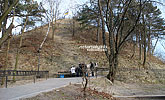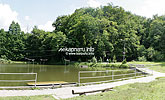Parks in Lviv
Vysoky Zamok (High Castle)
It is a local landscaping monument. The park was founded in 1835 at the slopes of the Castle (or Prince's) Hill. Its total area is 36,2 hectares.
It consists of two terraces. There is a gardener's house, a memory sign in honour of Maxym Kryvonis (one of Cossacks leaders), a restaurant and an observation point on the lower terrace of the park. On the upper terrace there is a man-made burial mound with an observation platform (413 m above sea level). It was dedicated to the 300th anniversary of Liublin union and was filled up in 1869—1900 by Polish community. There is also a fragment of the High Castle fortification wall. Lviv television centre with the tower (192 m) is located here, too.
In the park deciduous species prevail: chesnut tree, maple, sycamore maple, ash tree, lime tree, etc.
Public Garden "On the Ramparts"
It is the second park by age in Lviv with the area of 1,9 hectares.
In 1821 one of Lviv counsellors founded a park with footpaths and a suspension bridge. Trees and ornamental bushes typical for that time were planted there: chestnut tree, maple, lime tree,
ash, acacia, birch, lilac, guelder rose, etc.
A new public walk was called "Hubernatorski valy" (The ramparts of the Governor).
After World War II the captured German military equipment was exhibited at the northern part of the park (near the Gunpowder Tower). That's why it is called "Trofejka" (Trophy) even nowadays.
Ivan Franko Park
It is one of the oldest parks in Eastern Europe, the first public park in Ukraine. It occupies the area of 11,6 hectares.
At the end of XVI c. a rich citizen John Scholz-Volfovich laid the park here. To do this he laid out 1600 gold coins from his purse.
Over time, this park and neighboring lands became the property of Jesuits. The Jesuits had built brick buildings, and already in 1715 they started to build a brewery and an inn. At the end of XVIII c., when the Jesuit Order was abolished, this area became the property of the Austrian government.
In 1919 the park was named in honor of the Polish national hero Tadeusz Kosciuszko, but most people called it Jesuit garden or gardens for a long time. Today a lot of people in Lviv, especially those of older generation continue to call it the park of Tadeusz Kosciuszko.
Today in the park one can see plantation of trees of different periods. But the main stand of trees comes from 1855 and 1890 — the time of last two reconstructions. Though one can meet here more ancient species, three mighty giant oaks, for example (their age is more than three centuries). There are also alien crops in the park, most of them are located nearby the gardener's house.
The Street University events take place in the park area. There is a children's playground and sometimes brass band concerts.
Stryjsky Park
It is the largest and the most beautiful park in Lviv. It is also considered to be one of the best landscape parks in Europe (known in Japan as well). Stryjsky Park is a national monument of landscape architecture. It is located in the place named Sofiivka.
The park was founded in 1876-1877. The author of the project was Arnold Rohring, an Austrian landscape designer and architect.
The park territory (56 hectares) is divided into three landscape units: the lower zone, park area, upper terrace (the place of the former "Oriental Auctions" annually held here since 1922).
Stryisky Park is famous for its various collection of plants (more than 200 species), greenhouse and two alleys — of plane-trees and that of lime-trees.
Besides, the pond with white swans adds to the park's beauty greatly.
There is a single monument here — a monument to Jan Kilinski, a national Polish hero (1894, arch. J. Markovski, restored in 2009).
There is also one big summer attraction for children in the park — Lviv Children's Railway and a cinema.
Culture and Rest Park named after Bohdan Khmelnytsky
It is a local monument of landscape architecture, its total area is 26 hectares.
The park was laid in 1951, opened in 1959.
Its central axes is a central alley as long as 800 m. Flowerbeds and fontains, greenery and footpaths were located here on the terraces. The monuments to Lenin and Stalin were established there, too.
At that period the park was considered to be the largest object of landscape architecture of stalinism epoch.
But in 2009 one could see only two objects remained from the old times — the colonnade of the central entrance and the cinema "Druzhba" (Friendship) building. Nevertheless, it is still a good example of architectural adaptation to landscape and an apt use of historicism in architecture.
In summer there is an amusement park for children and adults, concerts and art exhibitions, an open-air cinema.
Znesinnya
It is one of the first regional landscape parks in Ukraine, founded within the city borders. "Znesinnya" is very interesting from the historic point of view. It occupies the area of 312,1 hectares. It is divided into the following zones: protected one, that of regulated recreation, zone of stationary recreation and administrative and supply section. One of the most prominent historic and cultural monuments is situated here — Ethnographical open-air museum.
Pohulianka
The park is located between such streets as Pasichna, Washington and Zelena and Pohulianka quarter. This quarter consists mainly of residential houses built in 1920-1930ies. The nothern part of the park is bordered by Botanical garden of Lviv University.
The total square is 100,33 ha. The central part of the park is Pasika (The Apiary) flow which is the source of the Poltva river and the main alley which leads from Pohulianka street to Pasichna and Washington streets.
In the park there are such tree species as birch, maple, sycamore maple and hornbeam but the most widespread are natural plantations of beech.
The park was founded in 1810. At that time the owner of this place was a famous patron and advocate Franciszek Venhlinsky. He built a small palace and planted the hill with beech on Pohulianka. So locals began to call this place "Venhlinsky's Forest", but the owner came up with a new name which he "borrowed" from Vilnius city.
In the middle of the 19th century the park with the whole quarter was bought by Yan Klein. He drained a park pond and built a brewery instead. Later there was opened a famous restaurant. During that time the park wasn't treated with a proper attention and it slowly turned into a forest. From 1948 till nowadays there was a winery instead of the brewery.
In 1984 the Pioneers' Palace was built on Pohulianka, nowadays there is the Centre for Children and Youth which has a tramline. Behind the Palace's building there are remains of an older water intake system called "Prybylo" (1839) with mermaid carvings.
Nowadays there are walking trails around the park. In its lower part decorative ponds are arranged. You can get to Pohulianka by tram # 7, which terminus is located nearby the main entrance to the park.
Lychakiv Park
It was laid in 1894. Arnold Rohring (the author of Stryjsky park) took part in it. It occupies the area of 12,36 hectares.
There are several observation grounds here with panorama of Lychakivska street, park Pohulianka and green hills of "Shevchenkivsky Hay".
The park is very calm and it rather resembles a forest.
In the park, not far from Lychakiv street, there is a monument to B. Glowacki, a national Polish hero, erected in 1905. The Hill of Glory is located in the southern part of the park. This military memorial complex was established after World War I.
The park plantation consists of Austrian pine, maple acutifoliate, sycamore maple and chesnut tree.
There is also a sports centre of Lviv National University here and a playground.
Botanic Garden of Lviv National University named after Ivan Franko
Officially it was founded in 1852, when professor Giacint Lobarzewski started the botanic garden at the slope of Kalicha Hora (Hill). Here, under his guidance, an arboretum with a greenhouse and a water header collector was laid in English style. The garden was used for a research work and collecting exotic plants.
Today the garden is famous for its collection of orchids and their hybrids. One can enjoy these beautiful flowers in the period of their blossoming.
A new garden unit was founded in 1911. It is located in Cheremshyna street. Karl Bauer, the author of the project of Lychakiv cemetery and that of Ivan Franko park, was the gardener here at the
second half of XIX c. Thanks to his efforts and practices, the Botanic garden of Lviv National Univesity became well-known outside the country.
Since 1998 the garden has had 5 scientific sections: section of tropical and subtropical flora, section of dendrology, that of herbaceous flora, of cultural flora and section of physiology and
biochemistry of plants.
During last 50 years the garden's funds were greatly enlarged by various species of plants. The total number now is 3353 items.
The collections of old spesies (with the age of more than 100 years) are the most important. The Rhododendron collection and the succulent plants, for instance, is nowadays the visit card of Lviv botanic garden.

 Ukraine
Ukraine Poland
Poland Slovakia
Slovakia
 Українською
Українською





















































